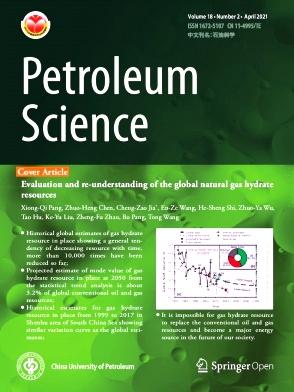Multi-fracture growth behavior during TPDF in a horizontal well of multi-clustered perforations: An experimental research
IF 6
1区 工程技术
Q2 ENERGY & FUELS
引用次数: 0
Abstract
Temporary plugging and diverting fracturing (TPDF), involving inner-fracture temporary plugging (IFTP) and inner-stage temporary plugging (ISTP), has been proposed as a widely applied technique in China, for promoting the uniform initiation and propagation of multi-clustered hydraulic fractures (HFs) in a horizontal well of the shale oil/gas reservoirs. However, how the key plugging parameters controlling the multi-fracture growth and the pumping pressure response during TPDF in shale with dense bedding planes (BPs) and natural fractures (NFs) is still unclear, which limits the optimization of TPDF scheme. In this paper, a series of TPDF simulation experiments within a stage of multi-cluster in a horizontal well were carried out on outcrops of Longmaxi Formation shale using a large-scale true tri-axial fracturing simulation system, combined with the acoustic emission (AE) monitor and computed tomography (CT) scanning techniques. Each experiment was divided into three stages, including the conventional fracturing (CF), IFTP and ISTP. Multi-fracture initiation and propagation behavior, and the dominant controlling parameters were examined, containing the particle sizes, concentration of temporary plugging agent (TPA), and cluster number. The results showed that the number of transverse HFs (THFs) and the overall complexity of fracture morphology increase with the increase in TPA concentration and perforation cluster number. Obviously, the required concentration of TPA is positively correlated with the cluster number. Higher peak values and continuous fluctuations of pumping pressure during TPDF may indicate the creation of diversion fractures. The creation of standard THFs during CF is favorable to the creation of diversion fractures during TPDF. Moreover, the activation of BPs nearby the wellbore during CF is unfavorable to the subsequent pressure buildup during TPDF, resulting in poor plugging and diverting effect. Notably, under the strike-slip fault stress regime, the diversion of THFs is not likely during IFTP, which is similar as the results of ISTP to initiate mainly the un-initiated or under-propagated perforation clusters. Three typical pressure curve types during TPDF can be summarized to briefly identify the hydraulic fracture diversion effects, including good (multiple branches or/and THFs can be newly created), fair (HF initiation along the slightly opened BPs and then activating the NFs), and bad (HF initiation along the largely opened BPs and then connecting with the NFs).
多簇射孔水平井 TPDF 过程中的多裂缝生长行为:实验研究
临时封堵与分流压裂(TPDF)包括内部裂缝临时封堵(IFTP)和内部阶段临时封堵(ISTP),是一种在中国广泛应用的技术,用于促进页岩油气藏水平井中多簇水力裂缝(HFs)的均匀萌发和传播。然而,在具有致密基底面(BPs)和天然裂缝(NFs)的页岩中,TPDF过程中如何控制多裂缝生长和泵压响应的关键堵塞参数仍不清楚,这限制了TPDF方案的优化。本文利用大型真实三轴压裂模拟系统,结合声发射(AE)监测和计算机断层扫描(CT)技术,在龙马溪地层页岩露头进行了一系列水平井多簇阶段TPDF模拟实验。每次实验分为三个阶段,包括常规压裂(CF)、IFTP 和 ISTP。研究了多重压裂的起始和扩展行为,以及主要的控制参数,包括颗粒尺寸、暂堵剂(TPA)浓度和集束数。结果表明,随着 TPA 浓度和穿孔簇数的增加,横向高频(THF)的数量和断口形态的整体复杂性也随之增加。显然,所需的 TPA 浓度与簇数呈正相关。TPDF期间较高的峰值和持续波动的泵压可能表明产生了分流裂缝。CF期间标准THF的形成有利于TPDF期间分流裂缝的形成。此外,CF期间井筒附近BPs的激活不利于TPDF期间的后续压力积累,导致堵塞和分流效果不佳。值得注意的是,在走向-滑动断层应力机制下,IFTP期间THFs的分流可能性不大,这与ISTP主要启动未启动或未充分推进的射孔群的结果类似。在 TPDF 过程中,可以总结出三种典型的压力曲线类型,以简要识别水力压裂分流效果,包括良好(可以新产生多个分支或/和 THF)、一般(沿轻微打开的 BPs 启动高频,然后激活 NFs)和不良(沿基本打开的 BPs 启动高频,然后与 NFs 连接)。
本文章由计算机程序翻译,如有差异,请以英文原文为准。
求助全文
约1分钟内获得全文
求助全文
来源期刊

Petroleum Science
地学-地球化学与地球物理
CiteScore
7.70
自引率
16.10%
发文量
311
审稿时长
63 days
期刊介绍:
Petroleum Science is the only English journal in China on petroleum science and technology that is intended for professionals engaged in petroleum science research and technical applications all over the world, as well as the managerial personnel of oil companies. It covers petroleum geology, petroleum geophysics, petroleum engineering, petrochemistry & chemical engineering, petroleum mechanics, and economic management. It aims to introduce the latest results in oil industry research in China, promote cooperation in petroleum science research between China and the rest of the world, and build a bridge for scientific communication between China and the world.
 求助内容:
求助内容: 应助结果提醒方式:
应助结果提醒方式:


